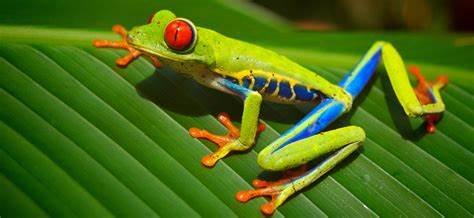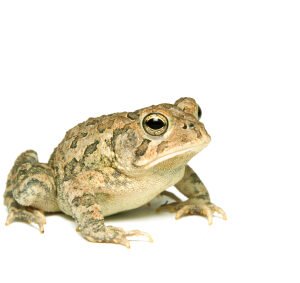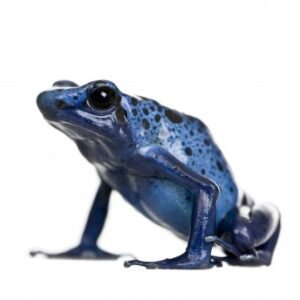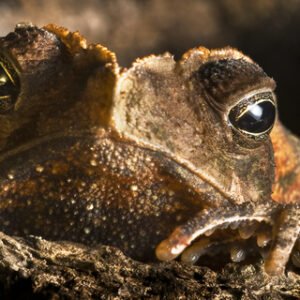The Fascinating World of the Red-Eyed Tree Frog
Introduction to the Red-Eyed Tree Frog
The red-eyed tree frog, scientifically known as Agalychnis callidryas, is an iconic amphibian renowned for its striking appearance and captivating behaviors. This species is easily identifiable by its brilliant green body, vivid red eyes, and distinct blue and yellow markings on its sides and limbs. These vibrant colors not only serve to attract mates but also act as a defense mechanism, as its bold patterns can confuse potential predators seeking to engulf this small creature.
Primarily found in the wetlands and tropical rainforests of Central America, the red-eyed tree frog inhabits regions ranging from southern Mexico to western Colombia. This frog often seeks refuge in the canopies of trees, where humidity is higher and where it can avoid direct sunlight. Such a habitat allows the species to thrive, utilizing the leaves as platforms for both resting and ambushing prey. The diet of the red-eyed tree frog predominantly consists of insects, including crickets and moths, which are abundant in their lush environments.
The red-eyed tree frog’s nocturnal nature adds to its charm, with its vibrant features becoming most visible under the moonlight, as it hunts for food during the night. This amphibian is not merely a visual spectacle; it plays a crucial role in its ecosystem. As both predator and prey, it contributes to the balance of its habitat. The frog’s presence signifies a healthy environment, reflecting the well-being of the ecosystem as a whole. Furthermore, its popularity among wildlife enthusiasts and researchers has made it a subject of various conservation discussions, highlighting the importance of preserving their natural habitats for future generations.
Behavior and Lifestyle
The red-eyed tree frog (Agalychnis callidryas) is a remarkable species known for its vibrant coloration and unique behaviors. These amphibians are primarily nocturnal, which means they are most active during the night. Their nighttime activities allow them to evade many predators, such as birds and snakes, that hunt during daylight hours. When evening falls, red-eyed tree frogs leave their hiding spots among the foliage of tropical rainforests, venturing out in search of food and mates.
Feeding behavior is an essential aspect of their lifestyle, as red-eyed tree frogs primarily consume insects, including crickets, moths, and flies. Their large, protruding eyes provide excellent night vision, making them adept hunters in darkness. The frogs utilize a sit-and-wait strategy; they often perch on leaves, camouflaged by their bright green bodies, while they wait for unsuspecting prey to come within striking distance. Once an insect approaches, red-eyed tree frogs use their long, sticky tongues to catch their meal swiftly and efficiently.
Mating rituals of the red-eyed tree frog are equally fascinating. They typically breed during the rainy season, as the increased moisture provides suitable breeding conditions. Males call out to attract females with a series of distinct vocalizations, often dominated by loud, croaking sounds. Once a female selects a male, the pair engages in amplexus, a unique mating embrace where the male clings to the female’s back. This position ensures that the male can fertilize the eggs immediately after the female lays them, which often occurs on the underside of leaves above water bodies to provide a safe environment for the developing tadpoles.
Throughout their lives, red-eyed tree frogs display remarkable adaptations that aid in their survival. Their bright coloration serves not only as a warning to potential predators but also as effective camouflage among the lush foliage of their environment. By studying the behavior and lifestyle of the red-eyed tree frog, we can gain a greater understanding of its role within the ecosystem, as well as the intricate relationships that exist between species in tropical environments.
Conservation and Threats
The red-eyed tree frog (Agalychnis callidryas) is a strikingly beautiful amphibian that has become a symbol of the rich biodiversity found in Central America. However, this vibrant species is facing numerous threats that jeopardize its survival. The primary concern is habitat loss, primarily due to deforestation. The destruction of tropical rainforests for agricultural expansion and urbanization directly impacts the red-eyed tree frog’s natural habitat, leading to a decline in suitable breeding and foraging areas. As a result, the fragmentation of forests isolates populations, making it difficult for them to interbreed and thrive.
Climate change poses another significant threat to the red-eyed tree frog’s habitat. Variations in temperature and precipitation patterns can disrupt the delicate ecosystems these frogs depend on. Increased temperatures may lead to drought conditions, while heavier rainfall can result in flooding, both of which can eliminate breeding sites and reduce food availability. Furthermore, climate-induced changes in moisture levels can also make the frogs more susceptible to diseases, such as chytridiomycosis, which has devastated amphibian populations worldwide.
Pollution also takes a heavy toll on the red-eyed tree frog’s environment. Pesticides and fertilizers used in agricultural practices can leach into nearby water sources, contaminating the habitats where these frogs lay their eggs. This exposure to harmful chemicals can lead to developmental problems and decreased survival rates. In response to these multiple threats, various conservation efforts are underway. Organizations are working to protect critical habitats through the establishment of reserves and public awareness campaigns. Additionally, promoting sustainable agricultural practices can mitigate some of the detrimental impacts of pollution. Individuals can also contribute by supporting conservation organizations and advocating for policies aimed at preserving the natural environments where the red-eyed tree frog thrives. Together, these efforts can help ensure a future for this captivating species.
Fun Facts and Cultural Significance
The red-eyed tree frog (Agalychnis callidryas) is not only a visually stunning species but also an intriguing subject for various cultural representations. These fascinating amphibians have a lifespan of around five years in the wild, although they can live longer in captivity. One of their most distinctive features is their bright red eyes, which serve to startle potential predators. When threatened, they can also flash vibrant colors from their body, displaying alluring hues of blue and yellow along their sides. This striking coloration plays a significant role in their survival, often confusing and deterring attackers.
In popular culture, the red-eyed tree frog has become an enduring symbol of rainforests and biodiversity, often appearing in children’s literature, animations, and television shows. Their vibrant appearance makes them a favorite subject for artists and photographers, contributing to a broader appreciation of environmental conservation. This species has found a special place in art, sometimes referred to in the context of conservation campaigns aimed at raising awareness of habitat preservation and the challenges faced by amphibians globally.
Moreover, the red-eyed tree frog has garnered attention in various media forms, becoming synonymous with the preservation of tropical ecosystems. Organizations and campaigns promoting amphibian protection utilize the image of this frog to inform the public about the ecological importance of these creatures. As a result, the red-eyed tree frog has transitioned from a mere inhabitant of Central American rainforests to an influential emblem in the fight for ecological awareness, representing both beauty and the urgent need for conservation efforts. Its impact resonates with nature enthusiasts, making it a beloved figure among those advocating for environmental responsibility.





